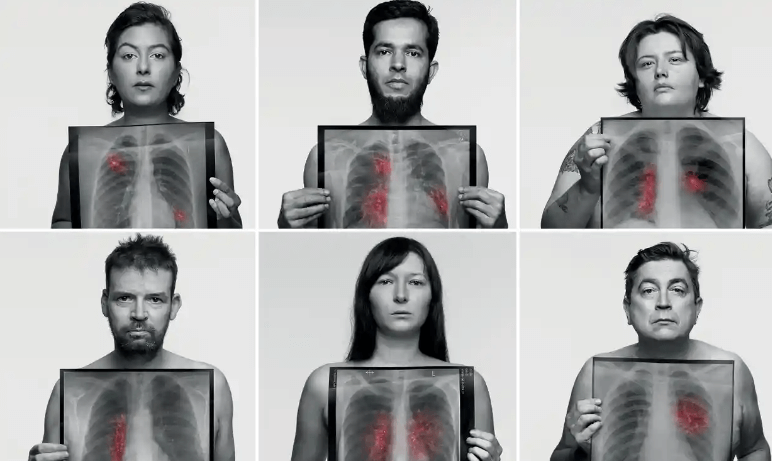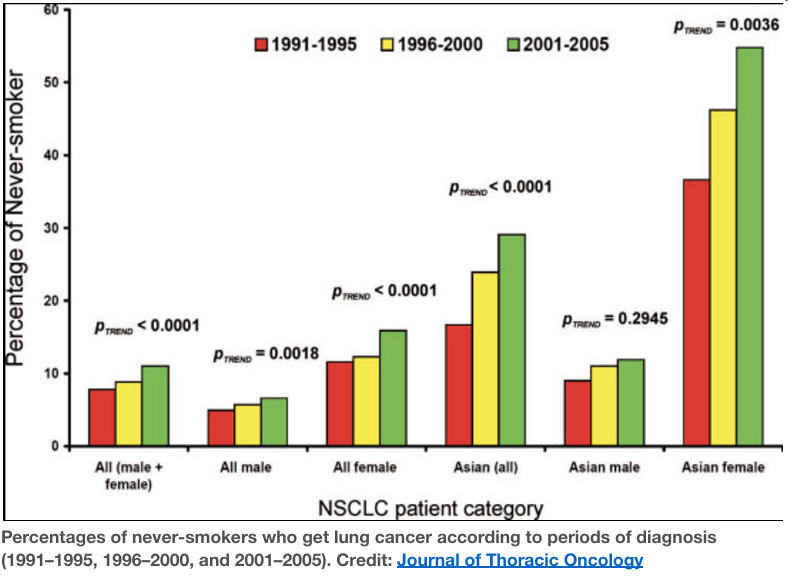Why do some heavy smokers never get lung cancer? And why do some people who never smoke get lung cancer? Answers are emerging for both of those questions. In both cases, much depends on our individual genetic make-up.
Lung cancer is the second most common cancer worldwide, accounting for 2.2 million new cases and 1.8 million deaths in 2020. It is also the most commonly occurring cancer for which the major cause is both known and preventable. Yet there remain mysteries about causation of lung cancer. How do some heavy smokers manage to avoid lung cancer? And what accounts for the occurrence of lung cancer in people who have never smoked?

In a just-published study, researchers at the Albert Einstein College of Medicine in the Bronx have found that some smokers’ DNA appears to become accustomed to the cancer-causing agents in cigarettes. This may help prevent dangerous mutations that result in lung cancer.
“The heaviest smokers did not have the highest mutation burden,” lead study author Dr. Simon Spivack said in a statement. “Our data suggests these individuals may have survived for so long in spite of their heavy smoking because they managed to suppress further mutation accumulation. This leveling off of mutations could stem from these people having very proficient systems for repairing DNA damage or detoxifying cigarette smoke.”
While this explanation may account for one mystery, another remains: What about the hundreds of thousands of people throughout the world who get lung cancer every year but never so much as took a drag?
Non-smoker’s cancer
Cigarette smoking accounts for between 80 and 90 percent of lung cancer cases in the West. The vast majority of lung cancers in high-income countries could be prevented if all smokers gave up their habit. While this is not likely to happen, just noting this fact is a crucial starting point for any discussion of lung cancer.
The only other common non-skin cancer for which the predominant cause has been identified is cervical cancer, which is caused by the human papilloma virus (HPV), and which can be almost totally prevented by vaccination.
There are striking differences in the epidemiologic, clinical, and biological characteristics of lung cancer in different parts of the world. In the U.S., where nearly 240,000 cases of lung cancer are diagnosed each year and where there are 130,000 deaths annually from the disease, lung cancer rates are roughly comparable in men and women, and are decreasing in both sexes. In contrast, in China, lung cancer rates are increasing in both sexes, but are roughly twice as high in males compared to females.
While most lung cancer in the West is associated with smoking, worldwide, it has been estimated that 15 percent of men and 53 percent of all women with lung cancer worldwide are never smokers.

Lung cancer in never smokers (LCINS), which tends to be of the adenocarcinoma cell type, is found predominantly in women and in East Asians. In contrast, the most common cell types found in lung cancer occurring in smokers are squamous cell and small cell types.
When considered as a distinct disease entity, lung cancer in never smokers ranked as the 7th most common cause of cancer death and the 11th or 12th most common incident type of cancer.
For at least 40 years, we have tried to identify environmental risk factors that might explain the occurrence of lung cancer in people who have never smoked. Potential factors that have been studied include passive smoking; residential exposure to radon gas; exposure to cooking fumes from coal and other fuels (particularly, in low-income countries); general air pollution; pre-existing lung disease; hormonal/reproductive factors (that might help account for the more frequent occurrence in women who never smoked); and inherited susceptibility. Other potential risk factors include asbestos and oncogenic viruses.
Although numerous studies have examined these factors, they appear to have relatively weak effects and are unlikely to account for the majority of cases (here, here, and here).
Environment vs. genetics
A 2012 review of the epidemiology of lung cancer in never smokers concluded that, “In any event, a large fraction of lung cancers occurring in never smokers cannot be definitively associated with established environmental risk factors, highlighting the need for additional epidemiologic research in this area.”
If strong environmental risk factors that account for lung cancer in never smokers are lacking, research examining molecular markers and driver mutations has produced novel and potentially clinically actionable results. Current evidence indicates that LCINS is a distinct disease with unique molecular and genetic characteristics.
Cancer results from the binding of mutagens to the DNA of critical genes, including tumor suppressor genes, proto-oncogenes, and genes involved in DNA repair. If the damage is not repaired, the transformed cell can go on to produce a clone, which can go on to develop into a full-blown (i.e., clinical) cancer. Tobacco smoke contains more than 60 mutagens that bind to, and chemically modify, DNA, leaving a distinctive mutational imprint on the lung cancer genome.
However, identifying the specific mutations that account for the potent carcinogenic effect of smoking on lung cancer has proved a challenge. The recent study from Albert Einstein College of Medicine used a new method to identify mutations in the progenitor cells that give rise a cell type that is susceptible to lung cancer (basal lung epithelial cells).
The researchers examined normal lung tissue from 14 never smokers and 19 smokers. Only one of the former had lung cancer, whereas 13 of the latter had lung cancer. The number of mutations increased with age in both smokers and never smokers, and with increasing pack-years of smoking up to 23 pack-years among smokers, but with no further increase in heavy smokers. However, the one never smoker who developed lung cancer did not have more mutations in normal lung cells than the never smokers who were free of lung cancer.

Notably, the smokers who developed lung cancer did not have more mutations in their normal lung tissue than the smokers who did not develop lung cancer. Thus, it is not clear which mutations associated with smoking determine who goes on to develop lung cancer, or whether it is a matter of susceptibility factors or just bad luck.
Although smoking is a powerful risk factor for lung cancer, it’s also known that susceptibility genes also play a role in lung cancer, as well as in cancer generally. This is apparent from the fact that most smokers never develop lung cancer.
Why are Asians more vulnerable?
It’s been long recognized that the pattern of lung cancer in Asia differs from that seen in the West. Smoking rates have been much lower in Asian women compared to Asian men, and women tend to develop the adenocarcinoma cell type, which occurs in the periphery of the lung, as opposed to squamous cell and small cell lung cancer, which occur in the main bronchi.

In the early 2000s it was noted that the response to treatment with epidermal growth factor receptor tyrosine kinase (EGFR-TK) inhibitors, such as gefitinib and erlotinib, among patients with non-small cell lung cancer (NSCLC) was markedly more effective in never smokers than in smokers. The benefit of treatment included statistically significant increased response rates, longer interval to progression, and/or longer median overall survival. This improved clinical response was most evident in patients from East Asia, in women, and in cases with the adenocarcinoma cell type.
Thus, lung cancer in smokers and that occurring in never smokers, particularly in East Asian women, appear to present two contrasting facets of lung cancer. In the first case, a potent carcinogen has been identified, but the precise way in which it causes cancer is unclear. In the second instance, a driver mutation which leads to cancer has been identified in a large proportion of cases, but evidence for environmental triggers is either weak or lacking. (A driver mutation is a genetic alteration that is responsible for both the initiation and progression of cancer).

Other research has identified a number of striking differences in genomic signatures and driver mutations between lung cancers occurring in smokers versus in those who have never smoked. For example, mutations in the tumor suppressor gene TP53 are more common in lung cancers in smokers than in LCINS. In addition, mutations in the KRAS oncogene are also common in lung cancers occurring in smokers but are rare in LCINS (43% vs. 0%). Conversely, EGFR mutations are common in LCINS but rare in lung cancer occurring in smokers (in one large study: 54% vs. 16%).
In addition, next generation sequencing studies indicate that the total number of mutations involving genes in protein coding regions was significantly higher in smokers than in never smokers (median 209 vs. 18). This represents a 90 percent lower incidence of mutations in never smokers.
The smaller number of genetic alterations identified in lung cancer in never smokers suggests that the majority, if not all, may play a role in the carcinogenic process. For this reason, it has been suggested that lung cancer in never smokers may provide “a relatively enriched and easily identified set of oncogenic drivers for lung cancer.”
The more frequent occurrence of EGFR mutations in LCINS has been found in different populations and geographic regions. The discovery of activating EGFR-TK mutations led to a number of randomized clinical trials comparing EGFR-TK inhibitors to chemotherapy in the front-line treatment of patients with EGFR-TK mutations. These trials have now established EGFR-TK inhibitors as the standard front-line treatment for patients with advanced-stage NSCLC that is positive for EGFR-TK mutation. Patients who harbor an EGFR-TK mutation have a 60% response rate to erlotinib (Tarceva).
Two researchers involved the treatment of LCINS concluded their review as follows, “With the advances in sequencing technology and decreasing costs it is possible that, in the near future, advanced-stage LCINS may be primarily treated with molecularly targeted therapy, and it would be possible to achieve prolonged periods of disease control similar to the treatment of chronic myeloid leukemia (CML) and gastrointestinal stromal tumor (GIST).”
In spite of these advances, it must be emphasized that the landscape of mutations in lung cancer is complex, and there is a tendency for these cancers to develop resistance to the first-line targeted therapy. For this reason, intensive work is focused on new targeted treatments, combinations of several agents, and use of immunotherapies in addition.
Takeaways from new research on lung cancer in smokers and never smokers
First, epidemiologic studies investigating low-level, hard-to-measure, or subtle exposures, such as environmental tobacco smoke, radon exposure, and asbestos should focus on validated lifetime non-smokers, since smoking is such a powerful risk factor for lung cancer. (The risk of lung cancer posed by smoking is much stronger than that posed by asbestos).
Because so little is known about the causes of LCINS, there may be a tendency to overstate the importance of associations with potential risk factors that have been studied, rather than acknowledge that the findings of these studies are unlikely to account for a large proportion of LCINS.
In regard to passive smoking, a French study that examined major mutations associated with lung cancer in never smokers and smokers found no clear association between passive smoke exposure and a “smoker-like mutation profile” in lifelong, never-smokers with lung cancer. They concluded that, “Passive smoking alone appeared to be insufficient to determine a somatic profile in lung cancer.”
Second, characterizing the common and divergent mechanisms of malignant transformation in lung cancer occurring among smokers and that in never smokers could contribute to a better understanding of the genomic changes underlying malignant transformation and progression. As one group of researchers wrote, “The mutually exclusive nature of certain mutations is a strong argument in favor of separate genetic paths to cancer for ever smokers and never smokers.”
Third, the difficulty of identifying major causal factors in LCINS reminds us, that for many cancers, in spite of fifty years of epidemiologic research, we still have not identified major causal factors (exposures) for many common cancers, which might lend themselves to prevention. This is true for colorectal cancer, breast cancer, pancreatic cancer, prostate cancer, brain cancer, leukemia, and others.
This, in turn, underscores how difficult it is to pinpoint external causes of cancers that in most cases take decades to develop. Smoking as a cause of lung cancer and human papillomavirus as a cause of cervical cancer are exceptions to be noted and appreciated.
That said, we are seeing that identifying driver mutations that give rise to a particular cancer can lead to the development of effective targeted therapies that can greatly extend survival. These therapies represent long-sought, dramatic progress in treating serious cancers. This progress is independent of identifying the causal factor responsible for the cancer.
Geoffrey Kabat is a cancer epidemiologist and the author of Hyping Health Risks: Environmental Hazards in Daily Life and the Science of Epidemiology and Getting Risk Right: Understanding Science of Elusive Health Risks. He has a long-standing interest in lung cancer and, particularly, lung cancer occurring in never smokers, and has published on risk factors associated with that condition, including passive smoking, hormonal factors, and body weight.
This article previously appeared on the GLP on June 19, 2022.































